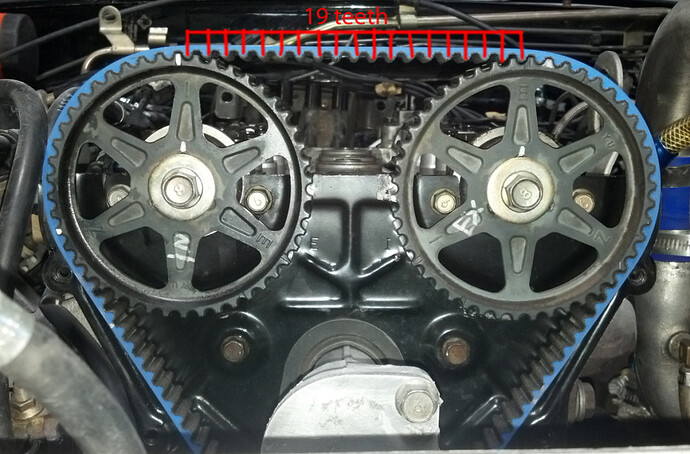Good morning everyone,
I’ve recently been in the middle of changing the waterpump, seals and all the belts on my 1.6 90bhp NA. I put a cam blocker in at the start of the job I think, my doubt is starting to creep in and I’m worried the timings going to be out. Is there any way of knowing this before I attempt to start? What’s the worst case scenario if it is out? I’m attempting to learn how to fix cars myself and think I may have screwed this up considerably and trying not to panic.
Appreciate any advice and tips
Many thanks
Ollie
If you are not sure lift the cam cover and rotate the engine until you get this view.
With the engine at TDC the E (right) and the I (left) should be at 12 o’clock and the re should be 19 teeth in between
1 Like
If it’s already assembled so you can no longer see the timing marks, turn the engine over at least two complete revolutions using the crank pulley (in the correct DOR) so at least if you have got it wrong there’s no chance of damage by trying to start it. This is standard practice with a cam belt change anyway.
If there’s no interference but it’s slightly out, the engine will probably run - just not very well.
I was under the impression that all the cambelt engines are non interference.
Is that wrong??
1 Like
No idea tbh. Meant as general advice, sorry.
I’ve done this job a few times and it is never as easy as I think it should be.
The secret is lining the cams and crank up whilst at the same time getting slack out of the belt on the right side so that it can be correctly taken up by the tensioner on the left side.
As Richard says, once you have the marks lined up, a little movement in the cams is really not an issue; in fact necessary to get belt slack to the left side. You will need to test by rotating nearly twice as crank turns twice to cams once. Forget belt position as this becomes random; just make sure the marks line up and tension of belt correct.
As mentioned these are in theory non interference engines so should not be possible for valves to hit pistons if the timing goes haywire. Do not test this theory please  .
.
1 Like
I have seen a technique where you slit the belt in half along its whole length, remove the outer half, replace that with the new belt, cut the remains of the old belt off and slide the new belt the rest of the way onto the sprockets.
Could this have worked??
2 Likes
Yup.
Watched a Utube video of that many years back on a Mk1.
Priceless. New belt was on in minutes bang on but it was a bit scary watching the old belt getting sliced.
While…the engine was ticking over!
Edit…Looked for it but it’s not there now…maybe too dangerous.
1 Like
The one I saw didn’t slice the belt with the engine running but it would certainly speed up the process, as long as you still had some fingers left…
1 Like
It’s currently disassembled waiting to go back together, so I will check first but will definitely try and hand crank it to see if it turns smoothly first, thank you
Sorry, what’s a non interference engine?
It sounds like a good method if I didn’t need to change the waterpump aswell and remove the lot anyway
1 Like
It’s an engine that has the valves and pistons out of range of each other.
The theory is that if the belt breaks, the engine survives intact.
1 Like
The 19 teeth is a good check, but yes these are non-interference engines in NA & NB as standard. If you start skimming the head aggressively for higher compression and then rev the nuts off the car by overevving or downshifting incorrectly then in theory they could touch.
But you’d have to be trying!
1 Like
Ah brilliant news, thank you!
Brilliant, thanks for that, nice to know just how far apart or difficult it is to cause damage
Don’t forget that the 19 teeth check is only half of the measurement. The two cam wheels could be 19 teeth apart and that means that exhaust and inlet cams are set up in harmony. BUT both could still be out of line with the crank pulley, they would just both be exactly the same amount out 
Anyway, 19 teeth is a good quick check, if you set cylinder number 1 to top dead centre using a long screwdriver trick then the cam gears should be at exactly the right position to check. If they’re not then the crank pulley is out by a tooth or two.
I think that was how they did it on an episode of car sos
1 Like
Brilliant thank you, I’ll do that too

 .
.